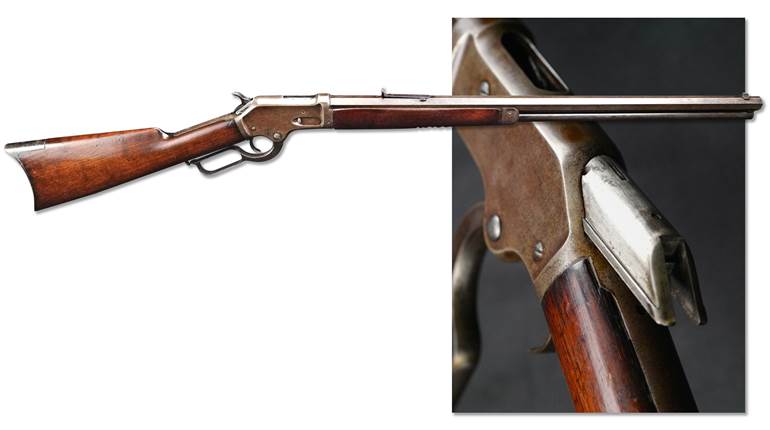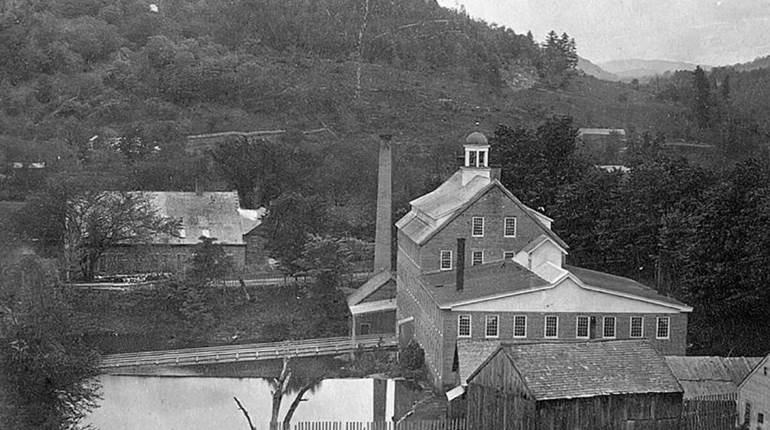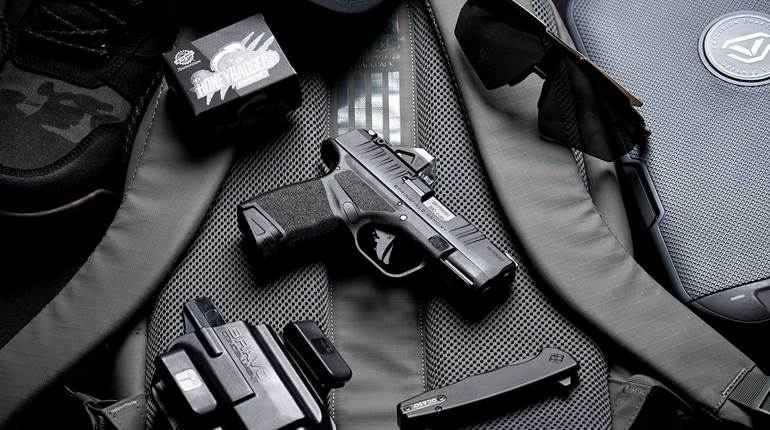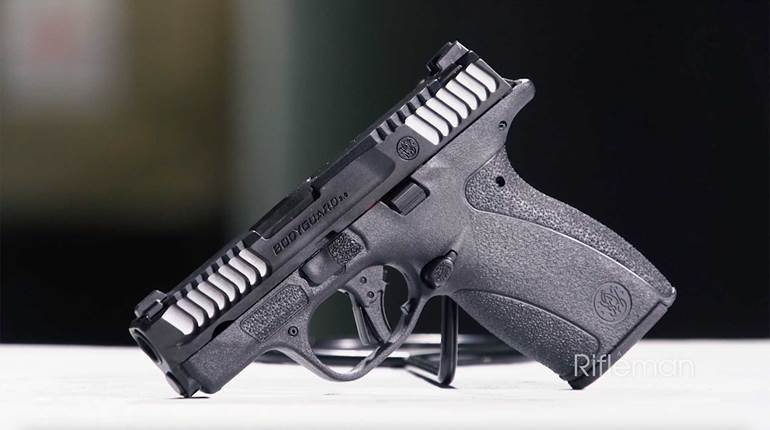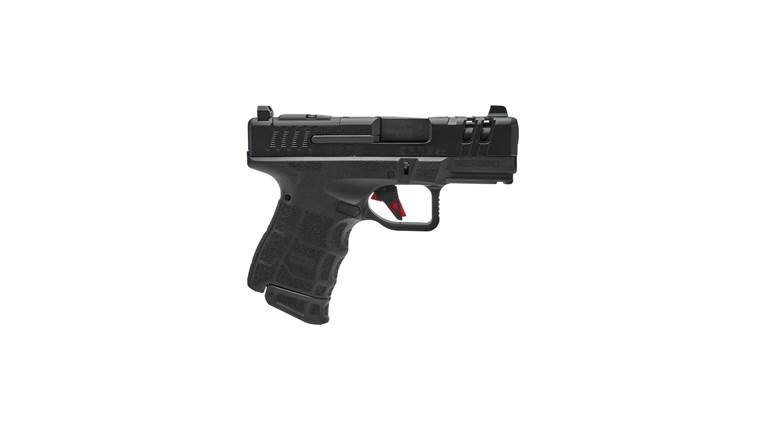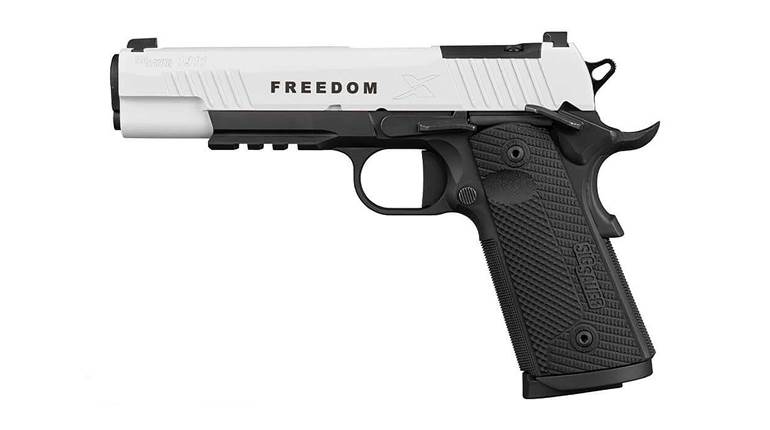
The Springfield Armory U.S. M1911, serial number 118461, (front) was issued to PFC Jack Agnew of the 101st Airborne Division during World War II. Next to it is a World War II Colt-made U.S. M1911A1. Shown with the guns are items belonging to the 101st Airborne’s S/Sgt. Ray Geddes, including his U.S.-issue watch, which broke at 1:26 a.m. on June 6, 1944, when Geddes parachuted into Normandy on D-Day.
This article was first published in American Rifleman, November 2006
Without question, the most famous United States military handgun of the 20th century is the Model of 1911 .45 pistol and its variants. Invented by the legendary John M. Browning and developed by the Colt Patent Firearms Manufacturing Co., the M1911 is known to several generations of Americans as the “.45 Automatic” or simply the “.45.”
The M1911 and its .45 ACP cartridge were developed in response to serious problems encountered with the .38-cal. revolvers used in the Philippines during the Spanish-American War and the subsequent “pacification” campaigns. The anemic .38 Long Colt cartridge failed miserably in combat, and the situation was so bad that some of the virtually antique .45-cal. Model of 1873 Single Action Army revolvers were called out of retirement and refurbished for use in the Philippines. The old blackpowder .45 Colt cartridge was a formidable man-stopper, although the antiquated single-action design left much to be desired.
After the fighting in the Philippines died down, the U.S. military establishment searched in earnest for an adequate replacement for the unsatisfactory .38 revolvers. A more modern Colt revolver design was adopted for use with the .45 Colt cartridge as the Model of 1909. These revolvers were procured in rather small numbers as a stop-gap measure. What the government really wanted was a semi-automatic or self-loading pistol chambered for a .45-cal. cartridge. After extensive trials and testing, the Model of 1911 pistol chambered for the .45 Automatic Colt Pistol (ACP) cartridge was adopted. It should be pointed out that while the M1911 is invariably referred to as an “automatic,” it is actually a semi-automatic or self-loading design.

The M1911 was manufactured by Colt from the time of its adoption and by the Springfield Armory in 1914 and 1915. By the time of America’s entry into World War I, the small pre-war U.S. Army and U.S. Navy had been substantially equipped with the new pistols, and production had slowed to a trickle. With the rapid expansion of America’s military machine, the demand for pistols soon overwhelmed the available supply. Colt immediately stepped up M1911 production, but Springfield was too heavily burdened with M1903 rifle production to resume pistol manufacturing. Plans were formulated to have M1911s produced by commercial firms. However, the only company—other than Colt—to turn out any real quantity during World War I was Remington-UMC, which produced approximately 21,000 during this period. The vast majority of M1911s made during World War I were Colts, but if the war had lasted even a few more months, six or eight other firms were ready to start full-scale production.
The M1911 proved itself to be an outstanding military handgun during World War I, and its potent, short-range stopping power was very valuable in many trench-warfare encounters. After the war ended, a great number of .45s went home in the duffel bags of members of the American Expeditionary Force, but there remained adequate numbers in inventory to meet the needs of the pared-down, post-war U.S. military.

The M1911 remained the standard service handgun of the U.S. Army, Navy and Marine Corps after World War I. Its success in France during 1917-1918 ensured its continued prominence as the standard American military sidearm, and no real developmental work was done during this period on another pistol. There were a few minor problems that led to changes in the configuration of the trigger, hammer and grip, and slight frame modifications. These changes were incorporated into new production pistols, and in June of 1926, the nomenclature was changed from M1911 to M1911A1. The OCM Item 5453 dated May 17, 1926, stated “… as a means of ready distinction between the two models, it is agreed that all pistols bearing serial numbers under 700,000 should be designated M1911 pistols, while pistols bearing serial numbers beginning at 700,000 should be designated M1911A1 pistols … .” Few M1911A1 pistols were manufactured from the time of its adoption until just before World War II because there were sufficient stocks of M1911s on hand to meet the demand.
This situation quickly changed with America’s involvement in World War II. Colt stepped up M1911A1 production, and contracts were awarded to several other companies to produce the pistol. Following are the firms that made the M1911A1 pistol during World War II and their approximate production totals during this period.
Ithaca Gun Co. 400,000
Remington-Rand 900,000
Colt 400,000
Union Switch & Signal 50,000
In addition, the Singer Company received an Educational Order for the production of 500 M1911A1s, but the firm never produced the .45 in quantity.

Older M1911s still in inventory were inspected and issued. Many of these guns required some work to make them serviceable. This refurbishing work, known as C&R (Cleaning and Repairing) rebuilding or overhaul by the Ordnance Department, generally consisted of replacing any worn or unserviceable parts and refinishing the pistols with the standard Parkerizing. The initials of the ordnance facility performing the rebuilding work were stamped on the frame.
The .45 automatic saw widespread use in all theaters of war. It was sometimes criticized as being heavy, awkward and inaccurate, but it was very reliable and possessed a great deal of stopping power. A good illustration of the .45’s effectiveness was an incident that occurred on Guadalcanal. “There was a moment of heart-stopping drama at the division CP when a sword-wielding Japanese officer stepped into the open with two riflemen and headed directly for Archer Vandegrift, who was in the open, alone and unarmed. [Master Gunnery Sergeant] Sheffield Banta, an utterly unflappable old salt, stopped typing a report long enough to unholster his .45-caliber automatic pistol and plug the officer dead in his tracks.”
 Many .45s were obtained by soldiers who were not authorized to be issued them, but these regulations were rarely enforced in combat zones. Handguns are basically arms of last resort, but the hefty .45 on the hip or shoulder gave many American fighting men a much-needed measure of security. It was generally a supplemental arm and saw very little use in combat situations. An interesting Marine Corps document dated October 23, 1943, entitled “Report on Infantry Weapons in Combat,” gave a brief synopsis on the arms used by a Marine Raider Battalion on New Georgia Island. The segment on the .45 simply stated, “U.S. Pistol, Cal. .45, M1911-M1911A1. Held up very well, but used very little.”
Many .45s were obtained by soldiers who were not authorized to be issued them, but these regulations were rarely enforced in combat zones. Handguns are basically arms of last resort, but the hefty .45 on the hip or shoulder gave many American fighting men a much-needed measure of security. It was generally a supplemental arm and saw very little use in combat situations. An interesting Marine Corps document dated October 23, 1943, entitled “Report on Infantry Weapons in Combat,” gave a brief synopsis on the arms used by a Marine Raider Battalion on New Georgia Island. The segment on the .45 simply stated, “U.S. Pistol, Cal. .45, M1911-M1911A1. Held up very well, but used very little.”
The .30-cal. M1 Carbine was originally conceived as a replacement for the pistol. Although the carbine was manufactured and issued in vast numbers, it never succeeded in replacing the pistol. As an illustration of the .45’s continued popularity during World War II, the U.S. Marine Corps Table of Organization & Equipment (TO&E) in 1942 authorized 798 .45 pistols for a division, by 1945, the authorized figure had been increased to 1,707. The situation was much the same in the U.S. Army. Even though the carbine was supposed to be the .45’s replacement, 1,878,742 M1911A1s were procured during World War II.
After World War II, the M1911A1 remained in the government’s inventory. It is interesting to note that no government-contract .45 automatics were made after 1945. The .45 automatic was the most widely issued U.S. handgun of World War II, and it provided valuable service to American fighting men.














